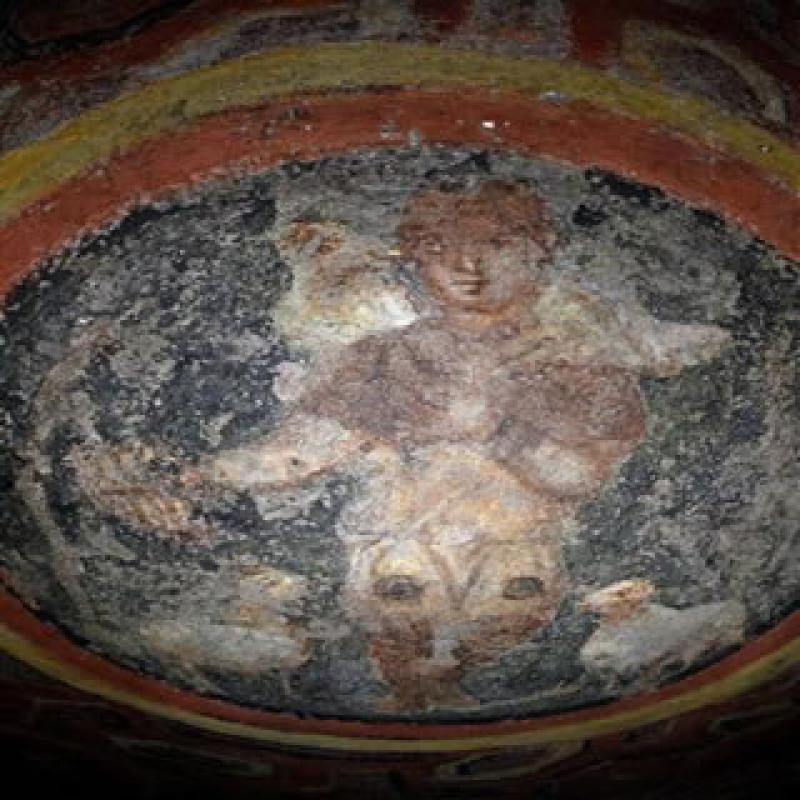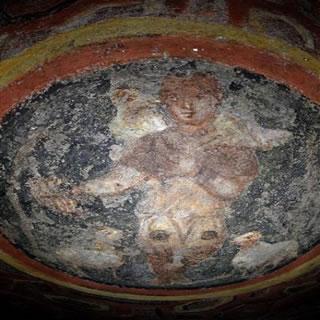THE GOSPEL SERIES: NewsTalkers 2018

THE GOSPEL SERIES
New Testament Book: Gospel of Matthew

It’s reasonable to expect the Jewish converts and believers in Jerusalem would need exposure to an explanation for the Messiahship of Jesus delivered from a Jewish standpoint. At the time of Matthew’s writing, the church had not separated from Judaism. Thus, it was predominately Jewish. Moreover, the church still was centered at Jerusalem and the capital was home to the Apostles.
The Authorship and Publication of the Gospel of Matthew
By Ron Jones, D.D. © The Titus Institute, 2010
According to Martha Howell and Walter Prevenier in their book, From Reliable Sources , the basis of our knowledge of the past are “sources.” They write,
“Sources are artifacts that have been left by the past. They exist either as relics, what we might call “remains,” or as the testimonies of witnesses to the past. The first kinds of sources, relics or remains, offer the researcher a clue about the past simply by virtue of their existence. The wooden columns found at the site of a prehistoric settlement testify, for example, to the existence of a people and tell historians something about their culture. The pegs or dowels they used to fasten building materials further enlighten scholars about their technical skills and artistic capacities. In contrast, testimonies are the oral or written reports that describe an event, whether simple or complex, such as the record of a property exchange." (Howell, Martha, Prevenier, Walter, From Reliable Sources, Cornell University Press, 2001, 17.)
The literary evidence of testimonies in the form of documents is powerful in bringing understanding of the past because of the nature of documents. Documents are a form of written communication. As we read them, people from the past are allowed to speak to us in the present. [i]
The universal testimony of the early church fathers is that Matthew the Apostle wrote the Gospel of Matthew in both Hebrew and Greek. [ii]
Matthew first wrote an original briefer version of his gospel in Hebrew (Aramaic) for the Hebrew Christians in Palestine and then wrote an expanded version of his gospel in Greek for Christians everywhere.
The historical literary evidence indicates that the early church fathers believed that Matthew originally wrote his gospel in Hebrew (Aramaic) and then wrote a Greek translation. The Hebrew Matthew was not widely used because few in the Christian world could read Hebrew Aramaic and the Greek Gospel of Matthew was more suitable for both Jewish and Gentile Christians who lived across the Roman Empire. The Greek Matthew was the Gospel circulated with the other three New Testament Gospels, which were in the Greek language.
This belief of Matthew’s authorship of both the Hebrew and Greek Gospel of Matthew can be clearly seen in the writings of three important church fathers, Irenaeus , Origen , and Eusebius .
Irenaeus (c.120–c.202) was a disciple of Polycarp who was a disciple of John the Apostle so his testimony concerning the authorship of the Gospel of Matthew, both in Hebrew and Greek is extremely important.
Origen (c.185–c.254) was a Christian scholar who was one of the few church fathers that knew both Hebrew and Greek.
Eusebius (c.265-c.340) was a church historian who wrote a large work called Church History.
Irenaeus, Against Heresies, 3.1.1
“Matthew also issued a written Gospel among the Hebrews in their own dialect, while Peter and Paul were preaching at Rome, and laying the foundations of the Church. After their departure, Mark, the disciple and interpreter of Peter, did also hand down to us in writing what had been preached by Peter. Luke also, the companion of Paul, recorded in a book the Gospel preached by him. Afterwards, John, the disciple of the Lord, who also had leaned upon His breast, did himself publish a Gospel during his residence at Ephesus in Asia.”
Irenaeus refers to the widespread use of the Greek Gospel of Matthew and then names its author as Matthew the apostle.
In the following passage, Irenaeus says that the four gospels are pillars of the church scattered throughout the world. This reference to the widespread use of the Gospel of Matthew can only refer to the Greek Gospel of Matthew. Only the Greek Gospel of Matthew was read by Christians everywhere. He then mentions the authors of each of these gospels including Matthew as the author of this Greek Gospel of Matthew and quotes from the Greek text of Matthew.
Irenaeus, Against Heresies, 3.11.8
“It is not possible that the Gospels can be either more or fewer in number than they are. For, since there are four zones of the world in which we live, and four principal winds, while the Church is scattered throughout all the world, and the ‘pillar and ground’ of the Church is the Gospel and the spirit of life; it is fitting that she should have four pillars, breathing out immortality on every side, and vivifying men afresh. . . . Matthew , again, relates His generation as a man, saying, ‘The book of the generation of Jesus Christ, the son of David, the son of Abraham;’ and also, ‘The birth of Jesus Christ was on this wise.’ This, then, is the Gospel of His humanity; for which reason it is, too, that [the character of] a humble and meek man is kept up through the whole Gospel. Mark, on the other hand, commences with [a reference to] the prophetical spirit coming down from on high to men, saying, ‘The beginning of the Gospel of Jesus Christ, as it is written in Isaiah the prophet,’ pointing to the winged aspect of the Gospel; and on this account he made a compendious and cursory narrative, for such is the prophetical character.” [iii]
This clearly indicates that Irenaeus believed that Matthew had written the Greek Gospel of Matthew. Since Irenaeus was a disciple of Polycarp who was a disciple of John the apostle, Irenaeus’ knowledge of the authorship of the Greek Gospel of Matthew was based on what was told to him by those who were in a position to know who actually wrote it. This is powerful testimony to Matthew’s authorship of the Greek Gospel of Matthew.
“ Origen accepted only four gospels: [Origen states] ‘For Matthew did not 'take in hand' but wrote by the Holy Spirit, and so did Mark and John and also equally Luke.’ In this quotation, Origen does not distinguish between Greek and Aramaic versions of Matthew, but includes the Greek Matthew as written by the apostle himself along with the other three gospels (namely, John, Mark, and Luke). Though Origen was aware that Matthew originally wrote in Hebrew…this latter statement implies that he made no distinction between the Aramaic and Greek versions, but included the Greek as equally authoritative with the other three gospels and also stressed its origin from the Holy Spirit.”
Eusebius refers to the Gospel of Matthew written in Hebrew and then in the same paragraph refers to the Gospel of Matthew written in Greek indicating that he saw them as one gospel. Eusebius' reference occurs in the passage below from his Church History. This indicates that he referred to them as the same work because the Greek Gospel was Matthew’s expanded translation of his original Hebrew Gospel. Eusebius mentions that Matthew and John were the only apostles who left Christians written memorials (Gospels).
Eusebius Demonstratio Evangelica 3.5
“The Apostle Matthew, if you consider his former life, did not leave a holy occupation, but came from those occupied in tax-gathering and over-reaching one another. None of the evangelists has made this clear, neither his fellow-apostle John, nor Luke, nor Mark, but [Matthew] himself, who brands his own life, and becomes his own accuser. Listen how he dwells emphatically on his own name in the Gospel written by him, when he speaks in this way: ‘And as Jesus passed by from thence, he saw a man, called Matthew, sitting at the place of toll, and he saith unto him, Follow me. And he arose, and followed him. And it came to pass, as he sat at meat in the house, behold, many publicans and sinners came and sat down with Jesus and his disciples.’”
(Quote is from The Proof of the Gospel Being The Demonstratio Evangelica of Eusebius of Caesarea, Tr. W.J. Ferrar, Vol.1 The Macmillan Company, New York, 1920 (CCEL))
And again further on, when he gives a list of the disciples, he adds the name "Publican" to his own. For he says:
[“] ‘Of the twelve apostles the names are these: First, Simon, called Peter, and Andrew his brother; James the son of Zebedee, and John his brother; Philip and Bartholomew; Thomas, and Matthew the publican.’ Thus Matthew, in excess of modesty, reveals the nature of his own old life, and calls himself a publican, he does not conceal his former mode of life, and in addition to this he places himself second after his yoke-fellow.”
[i] http://www.hebrewgospel.com./
[ii] http://jesusevidences.com/originntgospels/authorshippublicationmatthew.php
[iii] http://www.hebrewgospel.com./Matthew%20Two%20Gospels%20Main%20Evidence.php
The site rules, including but not limited to the code of conduct, Red Box Rules, and the Four B’s will be enforced.
Be On-Point.
Be Positive.
Be Respectful.
Or Be Gone!




The historical literary evidence indicates that the early church fathers believed that Matthew originally wrote his gospel in Hebrew (Aramaic) and then wrote a Greek translation. The Hebrew Matthew was not widely used because few in the Christian world could read Hebrew Aramaic and the Greek Gospel of Matthew was more suitable for both Jewish and Gentile Christians who lived across the Roman Empire. The Greek Matthew was the Gospel circulated with the other three New Testament Gospels, which were in the Greek language. — from the Article.
The site rules, including but not limited to the code of conduct, Red Box Rules, and the Four B’s will be enforced.
Be On-Point.
Be Positive.
Be Respectful.
Or Be Gone!
Very interesting seed. I've never wondered authorship before. Why do you consider this so important? I don't see why it matters much who wrote it...